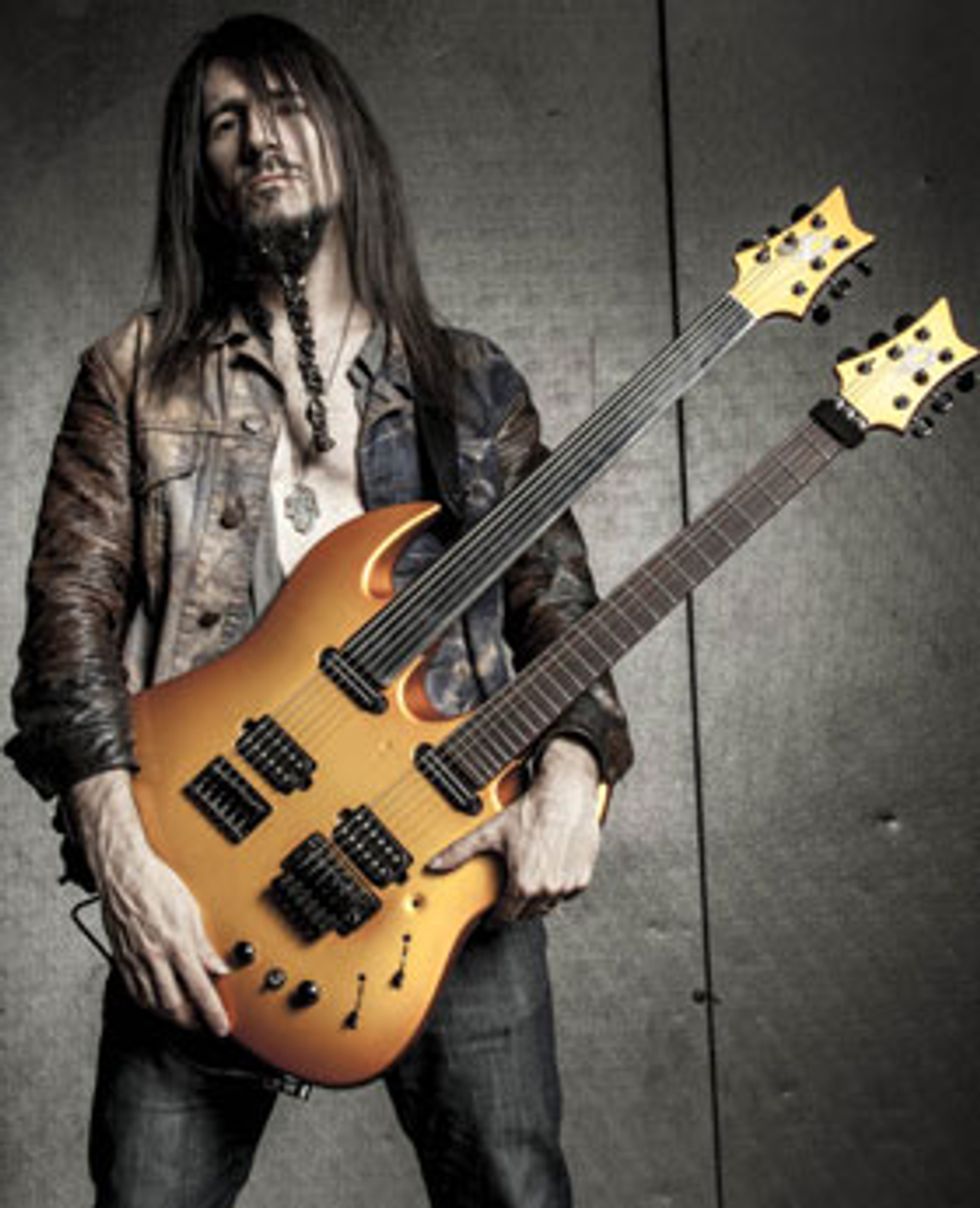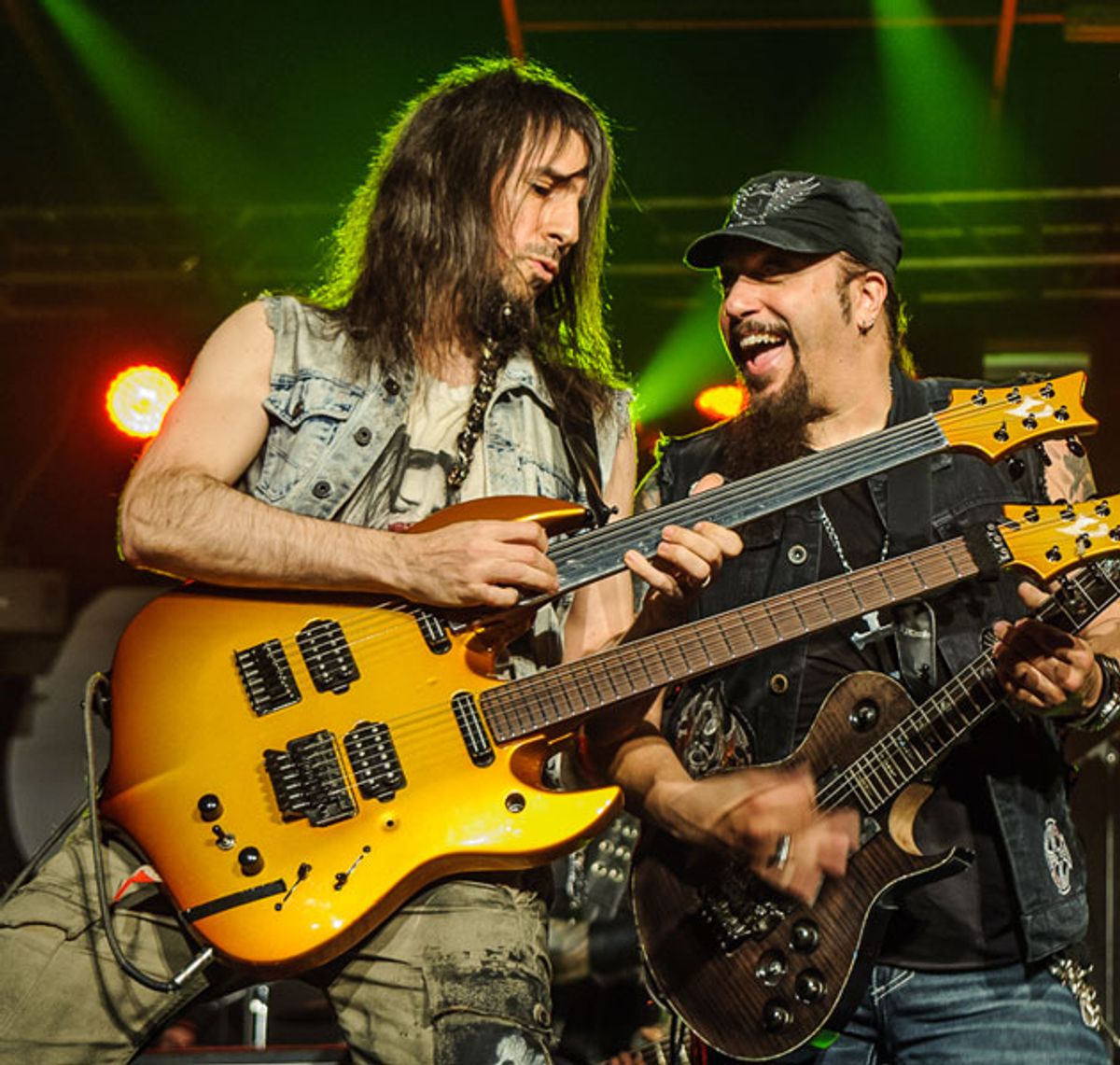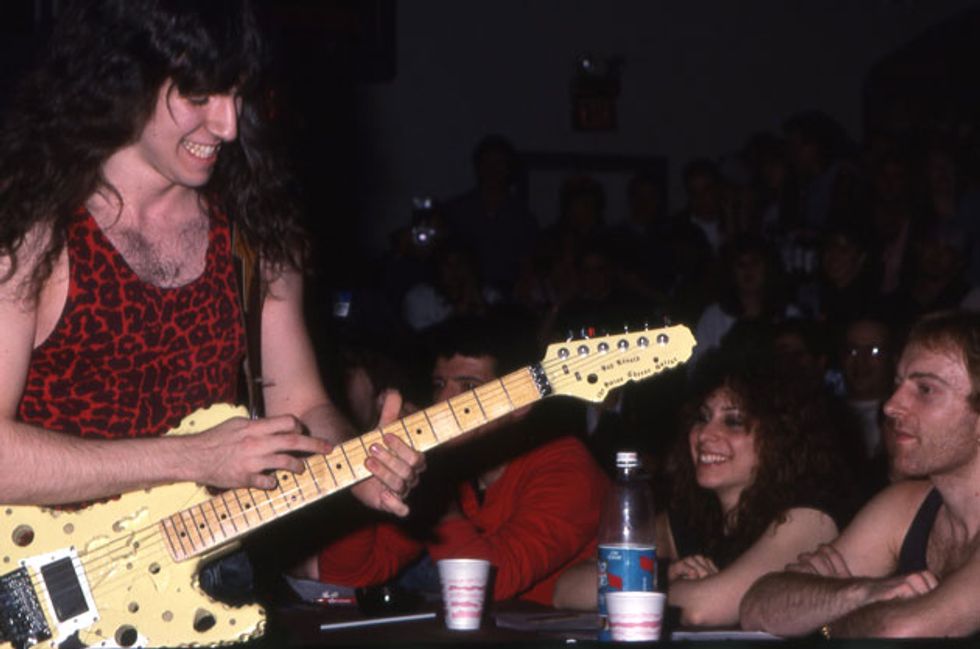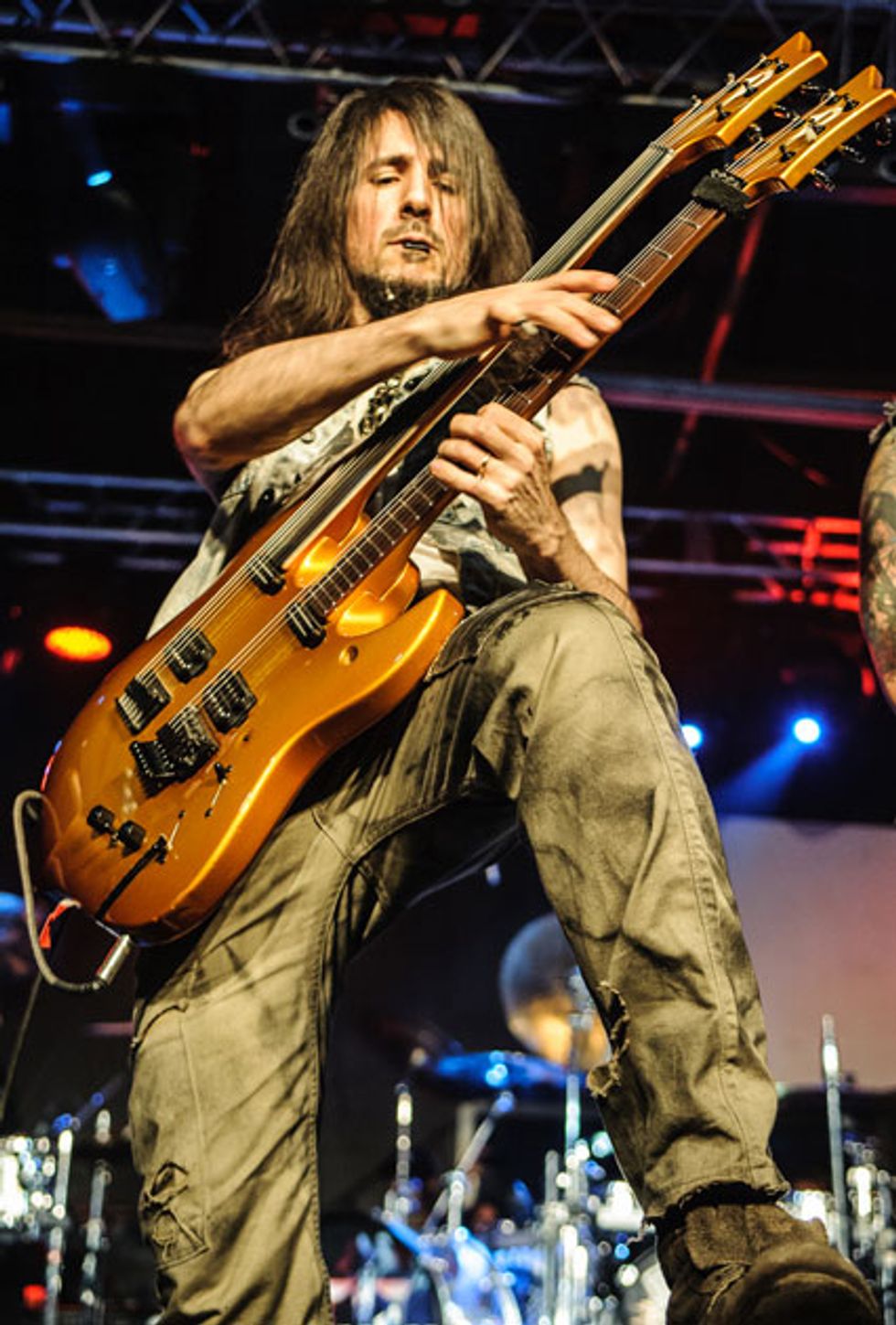Face-melting shredder, studio mastermind, technical innovator, and Guns N’ Roses hired hand.
Bumblefoot (aka Ron Thal) is a monster guitarist. His astounding chops, incredible ears, and innovative techniques are the stuff of legend. He’s also an accomplished singer, songwriter, teacher, transcriber, engineer, and producer. He’s as comfortable onstage as in the studio, and has been producing and recording music for as long as he’s been playing (since age 6).
Thal’s first break came in 1989, when he was featured in Guitar Player’s new talent column. He made more waves with his 1995 release, The Adventures of Bumblefoot, and built a cult following with subsequent albums and tours. But the cat was fully out of the bag in 2006, when Thal joined Guns N’ Roses, replacing outgoing shred master Buckethead. He subsequently toured the world, playing its biggest stages. Thal’s stellar guitar work is all over GNR’s 2008 release, Chinese Democracy, and the band’s live DVD, Appetite for Democracy 3D. He’s also worked with Jessica Simpson, Lita Ford, Guthrie Govan, and many other artists.
Thal is a fun interview subject. His custom doubleneck Vigier Double Bfoot was on his lap throughout our conversation. He demonstrated techniques, illustrated points, and played examples mid-sentence, displaying his command of contrapuntal fingerstyle classical, jazz chord melody, and of course, classic rock. He ripped through the Yngwie solos he learned note-for-note as a teenager. “I can’t believe I still remember this,” he said after playing—perfectly—an obscure gem from the first Alcatrazz album.
We need to reel it in.”
When Thal isn’t touring or recording, he teaches, hosts workshops, raises money for charity, and hypes his line of incendiary hot sauces. His latest album, Little Brother Is Watching, was released in February and he is—you guessed it—touring like a madman in support.
PG sat down with Thal to discuss his new album, influences, unorthodox guitar techniques, production work, guitars, and amps—and why being gear-obsessed isn’t always a good thing.
Some songs on your new album make it obvious that you’re a Beatles fan.
Oh yeah. My first musical loves were the Beatles and Kiss. Hearing Kiss Alive when I was five is what made me want to get out and do this. But as far as just really loving music, that was the Beatles. All five of them. I include George Martin, the producer, because he added everything that made those songs special.
How did they influence you?
As time goes on I realize more and more that music is about telling stories—sharing your overall feeling, the picture you envision, and trying to bring listeners into that experience so you’re there together. It comes from the words, the melody, the intensity, the dynamics—everything! It’s all the ingredients combined, every spice in there.

Photo by Catherine Asanov.
And Kiss was more about being a rock ’n’ roller?
Yeah. They were more about getting onstage and letting your energy out.
Who was your man in Kiss? Ace? Gene?
The great thing about bands like Kiss and the Beatles is that you know them on a first-name basis. Each name is so important to the entirety of it. If one of them wasn’t there, it just wouldn’t be what it was.
You’ve said that Eddie Van Halen gave you permission to do things. What did you mean?
That’s when I started chopping up guitars, pulling off frets, and getting into other things. Before that, I always thought guitar was just a tool for getting a song out there. But when I heard the things he was doing, I realized that this instrument can do so much more, and can have a life of its own. That’s when I started experimenting with what you can do with the string. You’re not just playing the fretboard—you’re playing the strings themselves. The string has sounds to offer beyond pressing it against the fret. I started really thinking about divisions of strings, harmonics, and what you can get out of that. For example, we’re always shortening the length of the string toward the bridge, but you can also shorten the length of the string toward the nut and get all these other sounds. [Plays an example, touching a metal thimble to the string above the bridge, shortening the string length and raising the pitches of the fretted notes].
It’s like putting a capo on the wrong end of the string.
Yeah. Once you have that, you realize you can get a lot of extra fingerings.
Did you always use a thimble?
I’ve tried other things, such as a nine-volt battery and a rubber band, but I needed something I could immediately access, and having a thimble on my fingertip seemed like the most practical way to do that. So rather than touching the string against the fret, I’m touching the fret against the string. That’s how I get everything else I need.
In your workshops you often encourage people to practice one thing while thinking about another. Why?
When your hands do something automatically, your brain is still telling them what to do. You’re still there doing it—you’re just not overdoing it. You have to practice letting it happen. Get used to not having to be on top of it. Otherwise, if something distracts you, you’re going to fumble. You have to loosen the grip and trust yourself that you’ll be okay. Everything that you want to do will happen without having to think about it.
So sitting in front of the television or having a guitar in your hand when you’re on the phone is a good way to practice?
Absolutely. There will be times when you do need to focus. But it’s definitely good to just let it happen while you’re doing something else or thinking about other things. Get used to having that little background piece take care of it all.
it sound good.”
Is it important to practice with a metronome?
The metronome is your friend. The metronome is never unimportant. Pros use metronomes. It’s how you gain stability playing to something other than just yourself. Your drummer is your metronome, and your drummer is playing to a metronome. If not, then he’s got a good internal one from all that practice he did do with a metronome. Guitar players need to use a metronome to keep from running amok. Guitarists tend to get overly excited, like a wild puppy. We start running in front of the beat and pissing all over the room. We need to reel it in. Otherwise we just rush too damn much and then blame the drummer. [Laughs.]
Lots of people love fast playing. Are you drawn to fast music, or is “fast” just an expression of something deeper?
The thing about speed is, not everyone can do it. It’s something you achieve over time, so it’s something that’s appreciated—it stands out. But speed can overshadow everything else that’s going on in the music, so it’s sometimes best to use it sparingly. It’s a strong spice, and a little goes a long way. You’ve got to remember who you’re making music for. Be conscious and considerate of your audience and what they want. If your audience is shred guitar players, then hell yeah, go crazy. It’s like wearing the right outfit for the right occasion. But what the hell is speed, anyway? It’s just another letter in your alphabet. Speed, chords, vibrato—they’re all just parts of your playing.
Ron "Bumblefoot" Thal's Gear
Guitars
Vigier Double Bfoot fretted/fretless doubleneck (with DiMarzio Chopper and Tone Zone pickups)
Vigier GV
Vigier recreation of Thal’s “Swiss Cheese” guitar
Vigier recreation of Thal's “Flying Foot” guitar
Amps
Engl Invader 100 (through a Marshall 4x12 cab)
Effects
TC Electronic Nova System
Dunlop Cry Baby wah
Strings and Picks
D’Addario NYXL (gauged .009-.046 for the fretted neck and .012-.056 for the fretless neck)
Various .9 or 1.0 mm picks with a bit of surface texture
Your recording skills seem as developed as your guitar playing. How did you learn your way around the studio?
I started when I was 6 years old. I had a cassette recorder in the corner of the room. We had a little nylon-string guitar. We figured out just how far back the drummer needed to be so that our levels would match. Once we’d recorded our music, we played it back facing another tape recorder and sang along—that’s how we’d overdub vocals. I couldn’t even play yet, but I was writing songs.Later we got a couple of microphones and a mixing board, and eventually a nice reel-to-reel Fostex 8-track, then an Alesis ADAT and a Tascam DA-88 synced to a PC running Cubase, and finally, just Cubase.
Do you have a room full of gear?
About 13 years ago I got a whole second house just for recording. I needed a place where I could truly live music and not have to watch the clock or worry about this and that. That’s where I record my albums, produce, and do everything else.
Do you have racks of compressors and effects?
No, plug-ins. Nothing sounds as good as tape and real stuff, but the main piece of gear you need is your ears. As long as your choices and judgment are good, and you know how to get the most out of what you have, your ears are what matter. I’ve heard a lot of shit come out of amazing studios, and I’ve heard amazing things come out of bedrooms. Don’t worry about the gear you don’t have—work with what you’ve got and make it sound good. There’s always a way to make it sound good.
Do you wear different hats for producing and playing?
When you’re performing you can’t think like a producer. You definitely need to shift gears, and over time you get better at doing that. You need to spill your guts, and then be the listener who asks, “Is this translating properly? Are we capturing it? What do we need to do differently?” Wearing the producer hat is like the producer telling the musician what to do—except it’s all you.
How do you coax great performances from other players?
It depends on the person. You have to know the person you’re working with. For example, some people want tough love. They want you to say, “No, that fucking sucks. Do it again. You’re better than this.” Other people want, “That was really nice, but why don’t we try it this way, just as a backup?” The goal is to get their best. It’s not always a comfortable process getting people to dig deep and fight through frustration, keeping it productive and positive with the goal of capturing the best moment.
Photo by Annie Atlasman.
Is your main guitar the Vigier Double Bfoot?
Yeah. This one in particular is only about two years old. Man, I have beaten the crap out of it. It’s so full of dents and torn paint and cracks and missing shaved-down wood chunks and loose screws—and I love it. It’s got mileage. I know where every dent is.
What’s it made out of?
Wood. [Laughs.] I am so bad with that! If I had to guess, I’d say it’s probably maple or alder. The fretted fingerboard is probably rosewood, and the fretless fingerboard is “I-metal”—it’s some sort of anti-metal. [According to Vigier, the guitar’s body is mahogany.]
And it doesn’t have tone controls.
No. Both necks have a volume knob and the 5-way pickup selector. [The positions are bridge humbucker, bridge single-coil, both pickups, both pickups out of phase, and neck alone]. It has a switch to choose between necks, a place to hold the thimble, and—just to be silly—a kill switch. I needed it for some of the Chinese Democracy stuff, but otherwise I don’t really use it. I’m a liver, not a killer!
The pickups are DiMarzios?
Yes, on both necks—a DiMarzio Tone Zone and a Chopper, a dual-railed humbucker. I love that pickup. It’s expressive, and it reacts like a single-coil, but with the fullness of a humbucker.
If you break a string, do you just go to the other neck?
I haven’t broken a string in years. I change my strings maybe once every six months. I just don’t break strings.
You didn’t change your strings every night on tour with Guns N’ Roses?
My tech would every two days or every two shows. I thought, “You’re going through all those strings! We could do a whole tour on one set, and it would be fine.”
What about amps?
For my own stuff I go out real simple. Whatever amp they have, I just plug in and play.If I have a bus or van or something with a trailer, I bring my Engl 100-watt Invader head and Marshall cabinet. But if I’m running across Europe doing a lot of workshops and things like that, I just use whatever they have. I think people are too dependent on gear, and they use it as a crutch. Of course, if you’re playing certain metal things and need a lot of saturation and certain harmonics, you won’t get that from a little clean Fender. But most of the time, it’s just go out and play, and don’t worry about nothing.
YouTube It
Bumblefoot’s solo segment onstage with Guns N’ Roses. Don’t miss the fretless thimble madness at 2:22!
How did it feel stepping into a guitar chair previously occupied by Slash and Buckethead?
I just walked into it thinking, “I’m going to jam with a bunch of guys on a bunch of songs, and we’re going to have some fun.” As far as playing iconic songs, you want to be respectful of the audience and remember that those were the melodies they came to hear. I play them and don’t try to rewrite the songs. But if there was an open area where I could jam, I’d just do my thing.
Did you play some of Slash’s solos note for note?
Yeah. Certain things you can’t even consider “solos”—they’re more like a written part of the song that people know and sing along with, and you don’t want to deprive them of that. Take “Sweet Child o’ Mine”: Everyone is waiting for those lines, and not playing them would piss them off. It would just be rude! However, if it’s an open jam like the end of “Paradise City,” that’s your chance to do your thing.
Special thanks to PG readers Chris Annarumo and Yngve Grøvnik, who contributed several of these questions.




